Book contents
- Frontmatter
- Contents
- Illustrations
- Maps
- Acknowledgements
- Glossaries
- Chronology
- Preface to the second edition: Towards 2020
- Introduction
- 1 Zionism and security
- 2 The Hebrew Republic
- 3 New immigrants and first elections
- 4 The politics of piety
- 5 Retaliation or self-restraint
- 6 The Rise of The Right
- 7 The Road to Beirut
- 8 Dissent at Home and Abroad
- 9 An insurrection before a handshake
- 10 The end of ideology?
- 11 The Killing of a Prime Minister
- 12 The Magician and the Bulldozer
- 13 ‘He does not stop at the red light’
- 14 An unlikely grandfather
- 15 A Brotherly Conflict
- 16 Bialik's bequest?
- 17 Stagnation and Isolationism
- 18 An Arab Spring and an Israeli winter?
- Bibliography
- Index
- References
18 - An Arab Spring and an Israeli winter?
Published online by Cambridge University Press: 05 March 2013
- Frontmatter
- Contents
- Illustrations
- Maps
- Acknowledgements
- Glossaries
- Chronology
- Preface to the second edition: Towards 2020
- Introduction
- 1 Zionism and security
- 2 The Hebrew Republic
- 3 New immigrants and first elections
- 4 The politics of piety
- 5 Retaliation or self-restraint
- 6 The Rise of The Right
- 7 The Road to Beirut
- 8 Dissent at Home and Abroad
- 9 An insurrection before a handshake
- 10 The end of ideology?
- 11 The Killing of a Prime Minister
- 12 The Magician and the Bulldozer
- 13 ‘He does not stop at the red light’
- 14 An unlikely grandfather
- 15 A Brotherly Conflict
- 16 Bialik's bequest?
- 17 Stagnation and Isolationism
- 18 An Arab Spring and an Israeli winter?
- Bibliography
- Index
- References
Summary
A Downward Spiral?
From the 1980s onwards, any outbreak of violence had resulted in a move to the Right in Israel. The rise of Islamism in the Arab world and particularly in the West Bank and Gaza in the first decade of the twenty-first century resulted in a move to the far Right. The perception of the Israeli electorate was that strong leaders and a determined government were required to defend them. However, both the Right and the far Right had other items on their governing agenda.
Netanyahu was sometimes seen as the prisoner of his coalition of the centre Right and the far Right. Avigdor Lieberman had replaced Ariel Sharon as his critic within. Pleas to ally the Likud instead with Kadima fell on deaf ears. The pattern of Netanyahu's tenure was to come out in support of an issue when there was a public outcry, only to backtrack partly when it had died down. In a pre-election year, he was acutely aware of the necessity not to leave the centre ground to Kadima or newly emerging politicians such as Yair Lapid. Sometimes the differences between the centre Right and the far Right surfaced, as in Lieberman's harsh condemnation of Netanyahu for his opposition to the establishment of a Knesset committee to investigate the funding of Israeli human rights organizations.
- Type
- Chapter
- Information
- A History of Modern Israel , pp. 405 - 420Publisher: Cambridge University PressPrint publication year: 2013



